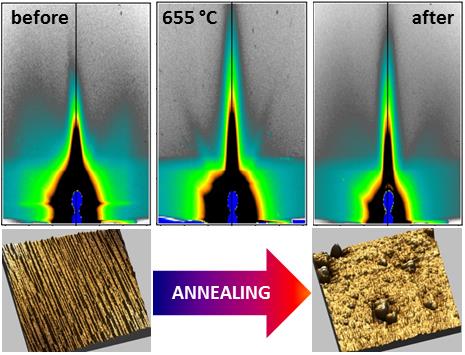
The thermal stability of parallel, high aspect ratio DySi2 nanowires and nanoislands self-organized on vicinal Si(001) is investigated as a function of the annealing temperature from room temperature up to 760 °C by in situ grazing incidence small-angle X-ray scattering (GISAXS).
Since the first demonstrations of self-organization of DySi2 in nanowires, nanoislands, and nanoclusters on the clean silicon surface in 1998 [2] rare earth silicide (RESi) nanostructures have been the subject of intensive research: their metallic nature, very low Schottky barrier heights, enhanced chemical stability and single crystallinity, along with the possibility of direct integration into silicon technology, has established them as very promising candidates for applications in optoelectronics, light-emitting technology, micro- and nanoelectronics as ohmic contacts, and interconnects.
Researchers from KIT, MPI Stuttgart and FMF Freiburg have investigated the thermal stability of parallel, high aspect ratio DySi2 nanowires and nanoislands, self-organized on vicinal Si(001), as a function of the annealing temperature, from room temperature up to 760 °C, using in situ grazing incidence small-angle X-ray scattering (GISAXS) at the Max Planck Beamline at ANKA. Due to its nondestructive nature, the statistically representative sampling over a large surface area and a large number of nanoobjects, and the ability to perform measurements in situ under ultra-high vacuum, GISAXS has become established as a valuable method for investigation of the morphological changes in nanostructures.
Transformation of the nanoobjects has been observed above a temperature of 500 °C with the nanowires collapsing to form small islands which then grow in size due to Ostwald ripening. To obtain a comprehensive understanding of the surface morphological changes, the results from the in situ GISAXS experiments are complemented by in situ atomic force microscopy (AFM) measurements performed before and after GISAXS experiments.
[1] A. Seiler, S.Ibrahimkutty, P. Wochner, R. Pradip, O. Waller, B. Krause, A. Plech, T. Baumbach, M. Fiederle, S. Stankov, Thermal Stability Studies of DySi2 Nanowires and Nanoislands by in situ GISAXS, J. Phys. Chem. C, 2016,
[2] Preinesberger, C.; Vandré, S.; Kalka, T.; Dähne-Prietsch, M. Formation of Dysprosium Silicide Wires on Si(001), J. Phys. D: Appl. Phys. 1998, 31, L43−L45
